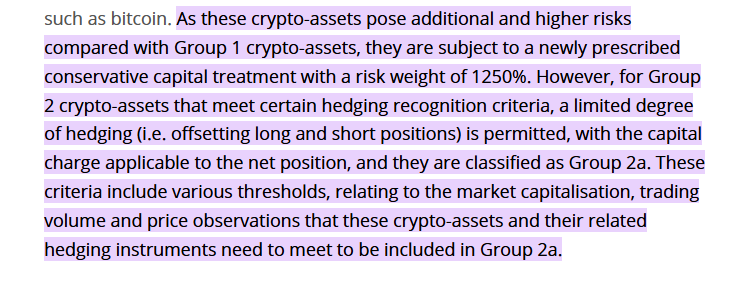World banking regulators are getting ready to overtake guidelines on how banks deal with crypto property, notably stablecoins, as strain mounts from main economies and business teams to revise stringent capital necessities set to take impact subsequent 12 months.
World regulators are reviewing banking guidelines on crypto holdings, particularly stablecoins, as a consequence of take impact subsequent 12 months. The unique Basel requirements from 2022 imposed heavy capital necessities, inflicting many banks to keep away from crypto. The assessment goals to replace these guidelines in response…
— Wu Blockchain (@WuBlockchain) October 31, 2025
The Basel Committee on Banking Supervision (BCBS), the world’s high banking standard-setter, is in discussions over potential amendments to its 2022 framework, which imposed a number of the hardest capital guidelines ever proposed for crypto holdings.
The requirements, designed after years of volatility in digital markets, required banks to assign a 1,250% threat weight to unbacked crypto property akin to Bitcoin, that means they need to maintain capital equal to the whole worth of their crypto publicity.
These measures, meant to guard banks from potential losses, successfully discouraged most establishments from providing crypto-related providers.
However the fast rise of stablecoins and a broader shift in how regulators and governments view digital property have triggered renewed debate.
Is Basel’s Guidelines about to Evolve With the Crypto Market?
Based on the Bloomberg report, america is main requires revisions, arguing that the unique requirements at the moment are outdated and inconsistent with the present construction of the crypto market.
Stablecoins, digital tokens pegged to property just like the U.S. greenback, have grown quickly, with new regulatory frameworks such because the U.S. GENIUS Act encouraging their use for funds.
But below the present Basel guidelines, permissionless stablecoins like Tether (USDT) and Circle’s USDC, which function on open blockchain networks, face the identical heavy capital costs as extremely risky cryptocurrencies akin to Bitcoin.
Senior finance executives mentioned this method has left banks on the sidelines, unable to serve rising institutional demand for digital asset providers.
A current report by The Banker revealed that the high-risk classification has made it “economically unviable” for banks to carry crypto on their steadiness sheets, forcing buying and selling exercise towards unregulated platforms.

The BCBS framework, first finalized in late 2022 and up to date in 2024, divides crypto property into two primary teams: Group 1, which incorporates tokenized conventional property and stablecoins with dependable backing mechanisms, and Group 2, which covers all different crypto property topic to punitive capital remedy.
The worldwide implementation of those requirements was delayed by one 12 months to January 2026.
World Regulators Diverge on Basel Crypto Requirements as Implementation Nears
Whereas the Basel Committee’s tips are non-binding, its 45 members, together with regulators from 28 jurisdictions, usually undertake them domestically.
Nevertheless, not all main areas are on the identical timeline. The European Central Financial institution helps implementing the present guidelines first, whereas the U.S., U.Okay., and a number of other Asian jurisdictions are looking for revisions earlier than the requirements come into pressure.
Singapore lately postponed its rollout by a 12 months to make sure world alignment, and Hong Kong plans to comply with in 2026 with lighter necessities for licensed stablecoins.
Within the European Union, the Basel requirements are being included by the Capital Necessities Regulation (CRR 3) and the Markets in Crypto-Belongings (MiCA) framework.
Draft guidelines from the European Banking Authority (EBA) revealed in August define detailed strategies for calculating crypto publicity throughout credit score, market, and liquidity dangers.
Unbacked crypto property will retain a 1,250% threat weight, whereas stablecoins backed by conventional property could obtain a decrease 250% cost.
The EBA’s method aligns with Basel rules however introduces transitional guidelines, permitting banks restricted engagement with digital property whereas extra everlasting frameworks develop.
The EU can also be getting ready for the launch of a euro-backed stablecoin in 2026, led by a consortium of 9 European banks, together with ING and UniCredit, below MiCA supervision.
European banks eye euro-backed stablecoins as a turning level — however can the EU transfer quick sufficient to match the US & Asia?#Euro #Stablecoinhttps://t.co/buLmb8VG5H
— Cryptonews.com (@cryptonews) September 26, 2025
The UK is taking a equally cautious path. The Financial institution of England has confirmed that upcoming guidelines will probably fall on the “restrictive finish,” encouraging banks to maintain low crypto publicity.
The Prudential Regulation Authority is growing a brand new prudential regime, CRYPTOPRU, anticipated to be finalized in 2026.
GENIUS Act Sparks Coverage Conflict Over Stablecoin Therapy in Banking Sector
In the meantime, U.S. regulators are reevaluating their prudential remedy of stablecoins following the passage of the GENIUS Act earlier this 12 months.
The legislation offers a framework for stablecoin issuance and funds however leaves open questions on how banking guidelines will adapt.
The Federal Reserve, OCC, and FDIC are coordinating on methods to implement Basel requirements whereas addressing home regulatory overlaps.
Trade teams have intensified strain on the Basel Committee to ease the capital burden. In August, associations together with the World Monetary Markets Affiliation and the Institute of Worldwide Finance urged regulators to drop what they referred to as “cliff-effect” penalties.
Wall Avenue teams urge Basel Committee to pause 1,250% crypto capital necessities, calling framework outdated for digital property.#WallStreet #Cryptohttps://t.co/34UBliWsi0
— Cryptonews.com (@cryptonews) August 20, 2025
Their joint letter argued that treating tokenized U.S. Treasury securities as high-risk just because they exist on public blockchains contradicts technology-neutral coverage rules.
The talk comes amid broader considerations about how stablecoins may reshape world finance.
A current report by Commonplace Chartered warned that over $1 trillion may stream out of emerging-market banks and into stablecoins by 2028, as customers in growing economies flip to dollar-pegged digital property as a safer retailer of worth.
The publish Crypto Banking Guidelines Face Overhaul as World Regulators Sound the Alarm on Stablecoins appeared first on Cryptonews.